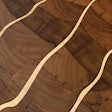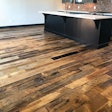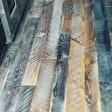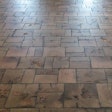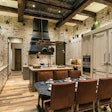
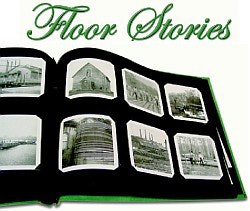
In the early 1900s, massive buildings were constructed to house large factories and their extensive assembly lines. Automobiles, airplanes and machine parts were churned out at a furious pace. The industrial revolution was born, and America's economy and culture entered a new chapter in history. These large buildings that helped fuel the industrial revolution are now an integral part of a much different kind of market—reclaimed wood flooring. The timbers from these historical buildings are just one of the major sources for the increasingly popular reclaimed flooring segment.
No matter the source—farm buildings, wooden cider vats, railroad ties, grain silos—a reclaimed floor becomes a conversation piece. Every reclaimed floor comes with a story, and most manufacturers research the history of the structure and its salvaged wood.
"When people say, 'My floor came from a Goodyear tire factory that made rubber-soled shoes for soldiers in World War I,' it's a pretty neat story to tell," says Chris Sy, vice president of sales at Stoddard,N.H.-based Carlisle Restoration Lumber.
The rich history of these floors is just one aspect that has contributed to the increased popularity of reclaimed wood. Consumers' growing environmental awareness also makes recycled wood an attractive eco-friendly option. Many consumers like the idea of utilizing wood that otherwise may pile up in a landfill. Homeowners who have reservations about using new growth wood in their home also may look to reclaimed wood flooring. "We've done 20 million board feet of reclaimed lumber, and we've never cut down a tree," says Patty Boden, marketing director at Ruckersville, Va.-based Mountain Lumber Company.

While the historical and environmental factors are attractive to consumers, reclaimed manufacturers attribute the surge in popularity to the unique look that antique wood lends to a room. Distressed, wide plank floors are in vogue, with specifiers opting for them in homes, offices and retail establishments. "People talk about recreating the family farmhouse, but they want to do it in a modern way,"says Carol Goodwin, vice president of Micanopy, Fla.based Goodwin Heart Pine. The rich tones, patina and character marks—such as nail holes common in reclaimed flooring—are difficult to replicate in anew wood floor.
Further fueling the demand is the rare wood found in some of these old buildings. Common species used for construction back then, such as long leaf heart pine and American chestnut, are now endangered or even extinct. Long leaf heart pine forests that once covered a 150mile-wide swath of land that ran down the East Coast from northern Virginia to eastern Texas were consumed by rapid building in the early part of the century. American chestnut filled 25 percent of the forest in the Appalachians until it was wiped out by blight in the early 1900s.
Sources
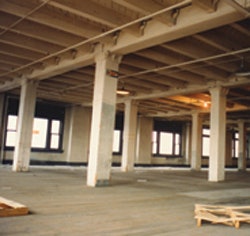
The most common sources for reclaimed wood flooring include old agricultural buildings, factories, warehouses and river recovered logs. But, as consumer demand for reclaimed wood increases,demand for these reclamation sources also increases. With so many people trying to get a piece of the reclaimed pie, high-quality salvaged wood sources now are a prized resource. "Years ago, we could just walk into a demolition site and they would give us lumber just to get it out of there, because all they were doing was sending it to landfills. It was costing them money to get rid of it,"explains Mountain Lumber Company's Vice President of Sales John Williams. "Over the years, it has changed drastically. Now it's basically a bidding war to buy the material."
Also increasing salvaged wood's value is the fact that it comes from finite sources—at some point, all of the old factories and barns will have been demolished, and all of the river logs will have been recovered. When that will happen is the million-dollar question. "We feel that more wood is still finding its way into landfills and burn piles than is being recovered and recycled," says Rick Guynn, sales manage rat Chambersburg, Pa.-based The Woods Company. He admits, however, that it's difficult to prove that fact.
Reclaimed manufacturers agree there is an abundant supply in the"industrial forest" now, but things could change in the future. When new construction rates increase, and old buildings are demolished and turned into shopping malls, restaurants and theaters, the reclaimed wood supply increases, but the long term supply of these old sources dwindles. Another factor threatening long-term supply is the fact that many old buildings are being retrofitted to make use of the existing historical structure.
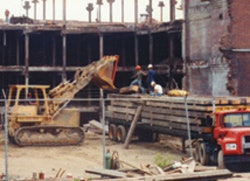
Some species are in more danger of becoming "re-extinct" than others. Carlisle's Sy explains that reclaimed chestnut, for example, is commonly found in smaller farm buildings that yield only a couple thousand feet from each structure. Heart pine, on the other hand, is salvaged from huge industrial buildings that may yield close to a million feet of flooring.
Many reclaimed wood flooring manufacturers are looking for new and creative sources not only to keep their supply from dwindling, but to set themselves apart in the growing reclaimed market. Beer vats, pickle vats, silos, water towers,railroad ties and piers from around the world all are being used to produce wood flooring. "Anywhere there's old wood, and enough of it in one place, people are recycling it,"says Jeff Horn, president of York,Pa.-based Aged Woods/Yesteryear Floorworks Company.
From structure to plank

Though reclaimed wood flooring manufacturers may differ slightly in the way they reclaim wood, most of the major companies follow the same basic process. The first step—finding a site with usable wood—may involve some detective work. Calls to government agencies and demolition contractors may yield results; other times, companies may already have relationships with suppliers who call when a site becomes available for salvaging. The next step is to investigate the prospective site and research the history of the building. This information gives the wood its historical character and can provide clues about its quality and whether it may contain chemical contaminants. Chemical plants, tanneries and other buildings that used large amounts of toxic chemicals are not acceptable reclamation sources. Wood containing lead paint also needs to be separated for lead abatement procedures.
Once a building is deemed acceptable, the deconstruction process begins. Wood is selected from portions of the building that will yield boards acceptable for flooring. The wood then is shipped to the factory,where it is prepared for milling. Nails and other metal are removed by hand before sending the wood through the sawmill. "Once you open a beam up, it's like a box of Cracker Jacks—you're not positive what you're going to get on the inside," Sy says. Once the beam is sliced, it then can be graded and grouped with similar boards.

The wood then follows the same process as new-growth lumber—it is kiln-dried to 6 to9 percent moisture content,bundled and packaged for shipment. One misconception is that because the wood is old, it's more stable and doesn't need to be kiln-dried;however, reclaimed wood can have a moisture content just a high as new-growth wood. Kiln-drying also sterilizes the wood and kills worms and insects that may be lurking in the boards. "Kilndrying can greatly reduce the chance of introducing wood-eating insects into the home," says Robert Smith, general manager at Locust Grove, Ga.-based Authentic Pine Floors.
Setting the standard
Currently, the biggest issue facing the reclaimed wood flooring industry is the lack of industry regulations and uniform grading standards. "One of the issues we find most challenging is the wide disparity in the quality of wood that's available," Guynn says. "There's an ever-increasing need to market your product in a way that allays any fears the public may have in using a product that's essentially unregulated and ungraded." Major manufacturers have created an association and are working together and with the NWFA to develop published definitions and rules for manufacturing. "One reason we started a reclaimed wood flooring association is that we keep hearing from consumers that they thought they were getting one thing—old growth heart pine. But when the product was installed, or even months later when it didn't turn color, they realized they didn't get what they thought they were getting,"Goodwin says.

Until specific rules and standards are set, the best way to ensure a quality, consistent product is to buy wood from reputable, established companies that have their own standards for milling, drying and grading.
There is a proliferation of companies with little or no experience trying to enter the market,and buying the wrong wood could lead to a failed installation and an unhappy customer. "There are many suppliers of reclaimed flooring, and many come and go as they exhaust their supply," Smith says.
Contractors need to ask questions and know what kind of floor they're getting. Some companies may ship wood that hasn't been kiln-dried or has defects still in the wood. Before installing are claimed floor, contractors should show homeowners several samples and determine exactly what look they are trying to achieve. Installers also need to know the difference between a "character mark" and a structural defect such as a severe crack in the board. Reputable manufacturers should take wood back if it's not up to their standards.
The price of beauty
Just because reclaimed wood flooring is used, it doesn't mean that it will costless than new-growth wood. In fact,reclaimed wood can cost twice as much. "The relative difficulty and cost associated with reclamation, coupled with demand and beauty of the product, generally creates a wood floor that is proportionately more expensive than its new counterpart," Guynn says. Securing sources, deconstructing a site and adding extra steps in the manufacturing process all increase its cost. Further adding to the bottom line is the high waste factor associated with salvaging wood from old buildings. "The waste factor is about 50 percent for barns, so for us to produce 500 square feet of flooring, we have to process 1,000square feet of raw material," Horn says.
The future of the past
Look for reclaimed flooring to continue to surge in popularity as more consumers learn about its unique look and demand for green building materials increases. Wider, more rustic looking boards continue to be a trend, and reclaimed flooring fits the bill. As competition increases, offerings from manufacturers will continue to become more innovative. Availability of products will change, and floors from new and interesting sources, such as Mountain Lumber's English oak made from old Guinness beer vats, will continue to appear on the market. Reclaimed manufacturers also hope to compete with new-growth flooring by offering end matching, prefinished flooring and engineered flooring.
These new innovations and modern technology may change the face of the market, but reclaimed wood flooring will always be a time capsule underfoot,forming a link to the past.




















